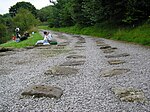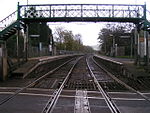Whaley Bridge railway station

Whaley Bridge railway station serves the Peak District town of Whaley Bridge in Derbyshire, England. The station is on the Manchester-Buxton Line 16+1⁄4 miles (26.2 km) south east of Manchester Piccadilly. Opened on 9 June 1857, the station was originally on the Stockport, Disley and Whaley Bridge Railway, built by the London and North Western Railway to connect with the Cromford and High Peak Railway and extended to Buxton in 1863. Until 1983, the station had an active signal box and served as a terminus for some trains to/from Manchester. The station is unusual for the line in that its platform one, where the main station building and ticket office is sited, is on the side for trains bound for Buxton, whereas platform two serves trains to Manchester. The platform is on a tight curve and was some 30 cm too low for the height of the carriages used, making it difficult to access for people with mobility problems. The problem was addressed by Network Rail in 2012, who rebuilt the Buxton platform and installed an Easy Access ramp on the Manchester-bound side.The station enjoys the support of the local community in the form of Friends of Whaley Bridge Station, a voluntary group dedicated to improving and maintaining the station buildings and grounds.
Excerpt from the Wikipedia article Whaley Bridge railway station (License: CC BY-SA 3.0, Authors, Images).Whaley Bridge railway station
Whaley Lane, High Peak Hockerley
Geographical coordinates (GPS) Address Nearby Places Show on map
Geographical coordinates (GPS)
| Latitude | Longitude |
|---|---|
| N 53.33 ° | E -1.985 ° |
Address
Whaley Lane
Whaley Lane
SK23 7AE High Peak, Hockerley
England, United Kingdom
Open on Google Maps










